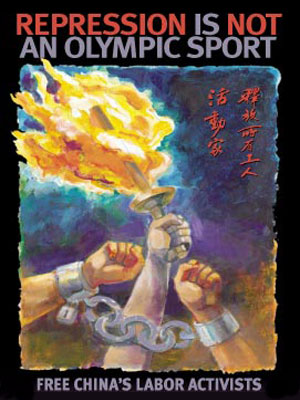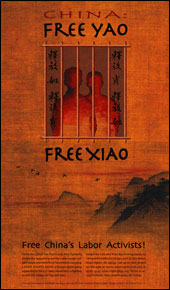.
[size=121]
I REALLY appreciate this opportunity to assist you in making a distinguishable association between the polar opposites of modern, independent, legally recognized Organized Labor agreements and communism.
You will find the differences important and worth repeating in the future.[/size]
…
[size=131]
Look at this site I think you will find it extremely helpful and revealing.[/size]
…
Here is an article, though dated, serves as a timeless example of the differences of the philosophical concepts that you seem to be having difficulty with:
[size=200]
Honda Workers Bypass `Toothless’ China Unions, Fueling Strikes[/size]
By Bloomberg News - Jun 30, 2010 7:25 PM ET
July 1 (Bloomberg) – Shaun Rein, managing director of China Market Research Group, talks with Bloomberg’s Linzie Janis about the threat of inflation in China and its potential impact on cost of living expenses. At least nine Chinese provinces and cities raised minimum wages by as much as a third today after Premier Wen Jiabao called for measures to head off growing worker unrest in the world’s third-largest economy. (Source: Bloomberg)
[size=120]When Huang Fengxia and her co-workers at Honda Lock Co. (Guangdong)’s factory in Zhongshan, China, decided to strike on June 9 for higher wages, the last person they considered contacting was their labor union representative.[/size]
[size=120]
“I have no idea what a labor union is or what they do,” said Huang, 26, whose one yuan ($0.15) monthly union membership fee gives her no access to collective bargaining, just a twice- yearly 200 yuan gift voucher during Chinese festivals. “It’s like a school club.”[/size]
Strikes at plants of Japanese automakers Honda Motors Co. and Toyota Motor Corp. mark an escalation in labor disputes in China, the world’s biggest manufacturer after the U.S., as a dwindling supply of cheap rural labor pushes up wage demands. [size=120]With no effective labor unions to negotiate with to head off stoppages, China’s factories face increased costs and lost production, said Mary Gallagher, director of the Center for Chinese Studies at the University of Michigan.[/size]
“These disputes are troublesome for employers and employees because they require time and money to resolve,” said Gallagher. [size=120]“If there was an apparatus that allowed for collective bargaining and negotiation, we might see a decline or stabilization in labor disputes.”[/size]
Profit at Honda may be cut by as much as 10 billion yen ($113 million), after Japan’s second-largest carmaker suffered the worst strikes in its 18-year-history in China, Goldman Sachs Group Inc. said. At least 10 suicides at Foxconn Technology Group, the maker of Apple Inc. iPhones and Hewlett-Packard Co. computers, led the Taiwanese electronics company to double wages for its lowest paid employees in Shenzhen.
‘Toothless’ Unions
“Historically, China’s labor unions have been rather toothless,” said Li Qiang, founder of China Labor Watch, a New York-based labor advocacy group. “When Honda factory workers went on strike they had no intention of using the union to negotiate. Workers had no idea about the concept.”
[size=130]
The All China Federation of Trade Unions, which represents China’s 169 registered labor unions, is closely affiliated to the government, hindering its efforts to win concessions and higher wages, Li said.[/size] The federation, founded in 1925, uses “the Constitution of the People’s Republic of China as the fundamental criterion for their activities,” according to its website. A spokesman for the federation said it “represents the interests of the Chinese workers” and was not a government agency.
[size=118]Labor organizations in the West such as the Detroit-based United Auto Workers union and the U.K.’s Trades Union Congress operate independently of the government and hire their own lawyers to advise on labor issues. [/size]
[size=120]
There are only five widely recognized countries that are clearly Communist in structure.
They are:[/size]
-
China

Mao Zedong took control over China in 1949 and proclaimed China as the People’s Republic of China, a communist country. China has remained consistently communist since 1949 although economic reforms have been in place for several years. China has been called “Red China” due to the communist party’s control over the country.
Sponsored Links
-
Cuba

A revolution in 1959 led to the taking over of the Cuban government by Fidel Castro. By 1961, Cuba became a fully communist country and developed close ties to the Soviet Union.
-
Laos

Laos, officially the Lao People’s Democratic Republic, became a communist country in 1975 following a revolution that was supported by Vietnam and the Soviet Union.
-
North Korea

Korea, which was captured by Japan in World War II, was divided following the war into a Soviet north and American south. Despite being led by the USSR beginning in 1945, North Korea did not become a communist country until 1948.
-
Vietnam

Vietnam was partitioned at a 1954 conference that followed the First Indochina War. While the partition was supposed to be temporary, North Vietnam became communist and supported by the Soviet Union while South Vietnam was democratic and supported by the United States. Following two decades of war, the two parts of Vietnam were unified and in 1976, Vietnam as a unified country became a communist country.
[size=120]
Here is the part that all of you may be missing;
Modern, independent, legally recognized, Organized Labor organizations DO NOT EXIST IN COMMUNIST COUNTRIES. PERIOD.
Organized Labor thrives in a Liberal Democracy.[/size]
[size=121]Do not feel bad or inferior if you still do not quite understand or feel comfortable.
THESE ARE PHILOSOPHICAL CONCEPTS that we are working with now. Give this time…[/size]
*Here is a trick - ALWAYS associate modern, independent, legally recognized Organized Labor agreements as the most important expression of Democracy!
[size=120]I hope this information helps!
I welcome you as you learn more about this important and fascinating subject of Organized Labor.[/size]
[size=130]Again, thank you for this opportunity!
Crafting the above for you was beyond GREAT!
[/size]
.







